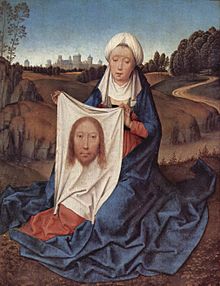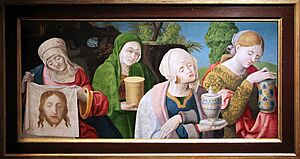Saint Veronica facts for kids
Quick facts for kids Saint Veronica |
|
|---|---|

Saint Veronica, by Hans Memling, c. 1470.
|
|
| Born | 1st century AD Caesarea Philippi or Jerusalem, Judea |
| Venerated in | |
| Canonized | Pre-Congregation |
| Feast | July 12 |
| Attributes | Cloth that bears the image of Christ's face |
| Patronage | images; laundry workers, pictures, photos, photographers, Santa Veronica, San Pablo City, Laguna |
Saint Veronica, also known as Berenike, was a woman from Jerusalem. She lived in the 1st century AD. Her story comes from Christian traditions outside the Bible. She is a well-known saint in many Christian countries.
Church tradition says that Veronica saw Jesus carrying the cross to Calvary. She felt great sympathy for him. She offered him her veil so he could wipe his face. Jesus accepted the veil. When he returned it, an image of his face was miraculously captured on the cloth. This special cloth became known as the Veil of Veronica.
The story of Veronica is part of the Stations of the Cross. This is a series of prayers and meditations. It remembers Jesus's journey to his crucifixion. Veronica's act of kindness is the sixth Station of the Cross. Many Anglican, Catholic, and Western Orthodox churches celebrate this moment.
Contents
The Story of Saint Veronica
The story of Saint Veronica and her veil is not found in the main Gospels of the Bible. However, there is a similar story. It tells of an unnamed woman who was healed by touching Jesus's clothing. This story is found in the book of Luke (Luke 8:43–48).
An older religious writing, the apocryphal Gospel of Nicodemus, calls her Berenikē. The name Veronica is a Latin version of this ancient name. Later, in the 11th century, the story grew. It said that Jesus gave her a portrait of himself on a cloth. Veronica then used this cloth to cure the Emperor Tiberius.
The idea of Veronica helping Jesus carry the cross became popular much later. This happened around 1380. It was in a widely read book called Meditations on the life of Christ.
The Veil as a "True Image"
Some experts think the legend of Saint Veronica started differently. They believe the cloth with Jesus's face was called the vera icon in Latin. This means "true image." Over time, people might have misunderstood this name. They thought "Veronica" was the name of a saint.
The Catholic Encyclopedia from 1913 explains this idea. It says that people believed in real images of Christ. To tell them apart, the oldest and most famous image in Rome was called the vera icon. This name soon became "Veronica" in everyday language.
Many old texts mention "Saint Veronica, or the Face of the Lord." This shows how the name of the image became linked to a person. Slowly, people imagined a person named Veronica. They created different stories about her.
This idea is similar to a legend in the Eastern Church. This legend is about the Image of Edessa, also called the Mandylion. It is another story of a miraculous image of Jesus's face.
Modern Devotion to the Holy Face
Saint Veronica was mentioned in the visions of Jesus seen by Marie of St Peter. She was a Carmelite nun in France in the 1800s. She started a special prayer practice called the devotion to the Holy Face of Jesus.
In 1844, Sister Marie said she had a vision. She saw Veronica wiping away spit and mud from Jesus's face. This happened on his way to Calvary. Sister Marie believed that disrespectful acts today are like adding to that spit and mud. Jesus told her in her visions that he wanted people to pray to his Holy Face. This would help make up for disrespectful acts and bad language.
This devotion was approved by Pope Leo XIII in 1885. Saint Veronica is remembered on July 12th.
What is Saint Veronica the Patron Of?
Saint Veronica is the patron saint of several groups. She is the patron of French mulquiniers. These were people who made fine linens. She is also the patron saint of photographers. Additionally, she is the patron saint of laundry workers.
See also
 In Spanish: Verónica (santa) para niños
In Spanish: Verónica (santa) para niños
- Acheiropoieta
- Jesus healing the bleeding woman
- List of names for the biblical nameless
- Relics associated with Jesus
- Scapular of the Holy Face
- Veronica's Veil
- Matthew 9
- Mark 5
Images for kids
-
Statue of Veronica by Francesco Mochi in a niche of the pier supporting the main dome of St. Peter's Basilica.
-
Albrecht Dürer's 1513 Veronica





